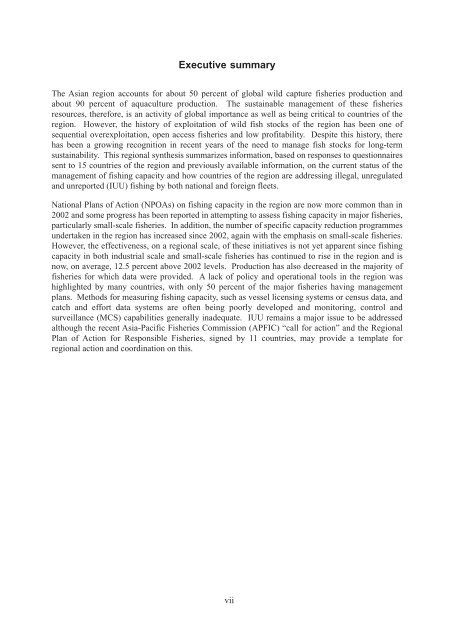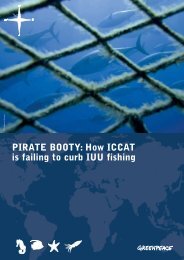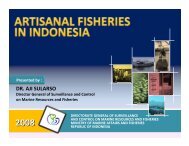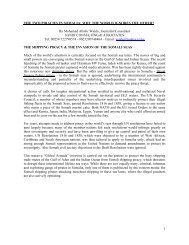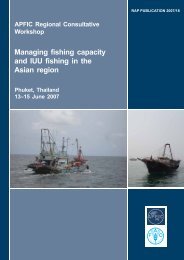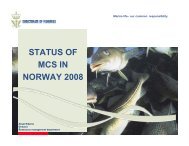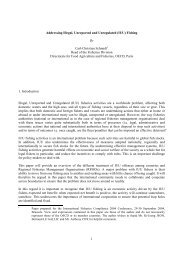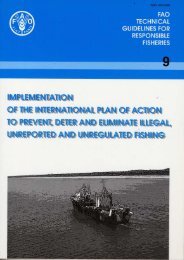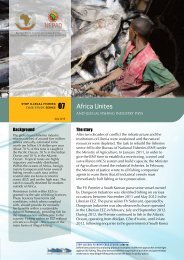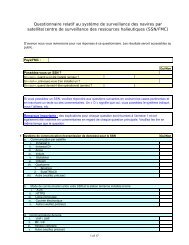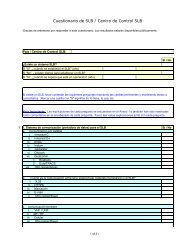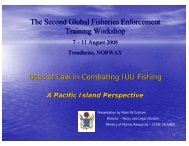Fishing capacity management and IUU fishing in Asia - FAO.org
Fishing capacity management and IUU fishing in Asia - FAO.org
Fishing capacity management and IUU fishing in Asia - FAO.org
Create successful ePaper yourself
Turn your PDF publications into a flip-book with our unique Google optimized e-Paper software.
Executive summaryThe <strong>Asia</strong>n region accounts for about 50 percent of global wild capture fisheries production <strong>and</strong>about 90 percent of aquaculture production. The susta<strong>in</strong>able <strong>management</strong> of these fisheriesresources, therefore, is an activity of global importance as well as be<strong>in</strong>g critical to countries of theregion. However, the history of exploitation of wild fish stocks of the region has been one ofsequential overexploitation, open access fisheries <strong>and</strong> low profitability. Despite this history, therehas been a grow<strong>in</strong>g recognition <strong>in</strong> recent years of the need to manage fish stocks for long-termsusta<strong>in</strong>ability. This regional synthesis summarizes <strong>in</strong>formation, based on responses to questionnairessent to 15 countries of the region <strong>and</strong> previously available <strong>in</strong>formation, on the current status of the<strong>management</strong> of <strong>fish<strong>in</strong>g</strong> <strong>capacity</strong> <strong>and</strong> how countries of the region are address<strong>in</strong>g illegal, unregulated<strong>and</strong> unreported (<strong>IUU</strong>) <strong>fish<strong>in</strong>g</strong> by both national <strong>and</strong> foreign fleets.National Plans of Action (NPOAs) on <strong>fish<strong>in</strong>g</strong> <strong>capacity</strong> <strong>in</strong> the region are now more common than <strong>in</strong>2002 <strong>and</strong> some progress has been reported <strong>in</strong> attempt<strong>in</strong>g to assess <strong>fish<strong>in</strong>g</strong> <strong>capacity</strong> <strong>in</strong> major fisheries,particularly small-scale fisheries. In addition, the number of specific <strong>capacity</strong> reduction programmesundertaken <strong>in</strong> the region has <strong>in</strong>creased s<strong>in</strong>ce 2002, aga<strong>in</strong> with the emphasis on small-scale fisheries.However, the effectiveness, on a regional scale, of these <strong>in</strong>itiatives is not yet apparent s<strong>in</strong>ce <strong>fish<strong>in</strong>g</strong><strong>capacity</strong> <strong>in</strong> both <strong>in</strong>dustrial scale <strong>and</strong> small-scale fisheries has cont<strong>in</strong>ued to rise <strong>in</strong> the region <strong>and</strong> isnow, on average, 12.5 percent above 2002 levels. Production has also decreased <strong>in</strong> the majority offisheries for which data were provided. A lack of policy <strong>and</strong> operational tools <strong>in</strong> the region washighlighted by many countries, with only 50 percent of the major fisheries hav<strong>in</strong>g <strong>management</strong>plans. Methods for measur<strong>in</strong>g <strong>fish<strong>in</strong>g</strong> <strong>capacity</strong>, such as vessel licens<strong>in</strong>g systems or census data, <strong>and</strong>catch <strong>and</strong> effort data systems are often be<strong>in</strong>g poorly developed <strong>and</strong> monitor<strong>in</strong>g, control <strong>and</strong>surveillance (MCS) capabilities generally <strong>in</strong>adequate. <strong>IUU</strong> rema<strong>in</strong>s a major issue to be addressedalthough the recent <strong>Asia</strong>-Pacific Fisheries Commission (APFIC) “call for action” <strong>and</strong> the RegionalPlan of Action for Responsible Fisheries, signed by 11 countries, may provide a template forregional action <strong>and</strong> coord<strong>in</strong>ation on this.vii


